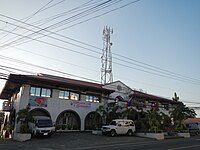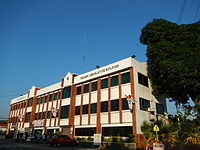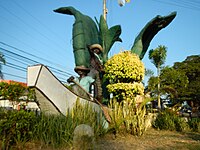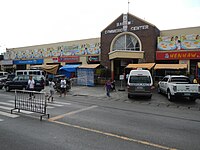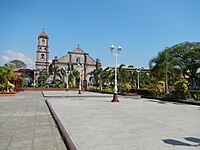Bauang: Difference between revisions
GerryYabes (talk | contribs) →Geography: update |
GerryYabes (talk | contribs) →Barangays: rearrange barangay as the data reference is from 2014 data, hence, outdated. |
||
| Line 191: | Line 191: | ||
===Barangays=== |
===Barangays=== |
||
Bauang is politically subdivided into 39 barangays. These barangays are headed by elected officials: [[Barangay Captain]], [[Sangguniang Barangay|Barangay Council]], whose members are called [[Barangay Kagawad|Barangay Councilors]]. All are elected every three years. |
Bauang is politically subdivided into 39 barangays. These barangays are headed by elected officials: [[Barangay Captain]], [[Sangguniang Barangay|Barangay Council]], whose members are called [[Barangay Kagawad|Barangay Councilors]]. All are elected every three years. |
||
{{Div col|colwidth=15em}} {{div col end}} |
|||
{| class="wikitable" |
{| class="wikitable" |
||
|+The 39 [[barangay]]s of the Municipality of Bauang<ref name=2010Census>{{cite web|url=http://census.gov.ph/sites/default/files/attachments/hsd/pressrelease/Cordillera%20Administrative%20Region.pdf |title=2010 Census of Population and Housing: Population Counts - Cordillera Administrative Region |publisher=[[Philippine Statistics Authority]], April 4, 2012 |access-date=November 16, 2014 |url-status=dead |archive-url=https://web.archive.org/web/20150626132646/http://census.gov.ph/sites/default/files/attachments/hsd/pressrelease/Cordillera%20Administrative%20Region.pdf |archive-date=June 26, 2015 }}</ref> |
|+The 39 [[barangay]]s of the Municipality of Bauang<ref name=2010Census>{{cite web|url=http://census.gov.ph/sites/default/files/attachments/hsd/pressrelease/Cordillera%20Administrative%20Region.pdf |title=2010 Census of Population and Housing: Population Counts - Cordillera Administrative Region |publisher=[[Philippine Statistics Authority]], April 4, 2012 |access-date=November 16, 2014 |url-status=dead |archive-url=https://web.archive.org/web/20150626132646/http://census.gov.ph/sites/default/files/attachments/hsd/pressrelease/Cordillera%20Administrative%20Region.pdf |archive-date=June 26, 2015 }}</ref> |
||
Revision as of 17:37, 11 June 2023
This article needs additional citations for verification. (September 2021) |
Bauang | |
|---|---|
| Municipality of Bauang | |
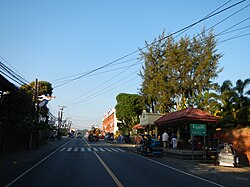 Approaching the Bauang town center along the National Highway | |
| Nicknames: | |
| Motto(s): Sulong Bauang 2030 and Vineyard City of the North by 2030 | |
 Map of La Union with Bauang highlighted | |
Location within the Philippines | |
| Coordinates: 16°32′N 120°20′E / 16.53°N 120.33°E | |
| Country | Philippines |
| Region | Ilocos Region |
| Province | La Union |
| District | 2nd district |
| Founded | January 5, 1586 |
| Barangays | 39 (see Barangays) |
| Government | |
| • Type | Sangguniang Bayan |
| • mayor of Bauang[*] | Menchie L. de Guzman |
| • Vice Mayor | Henry A. Bacurnay Jr. |
| • Representative | Sandra Y. Eriguel |
| • Municipal Council | Members |
| • Electorate | 52,808 voters (2022) |
| Area | |
• Total | 73.15 km2 (28.24 sq mi) |
| Elevation | 41 m (135 ft) |
| Highest elevation | 317 m (1,040 ft) |
| Lowest elevation | 0 m (0 ft) |
| Population (2020 census)[5] | |
• Total | 78,449 |
| • Density | 1,100/km2 (2,800/sq mi) |
| • Households | 19,796 |
| Economy | |
| • Income class | 1st municipal income class |
| • Poverty incidence | 7.54 |
| • Revenue | ₱ 372.3 million (2020), 185.4 million (2012), 190.4 million (2013), 226.3 million (2014), 242 million (2015), 309.7 million (2016), 270.7 million (2017), 387.2 million (2018), 302.3 million (2019), 495.7 million (2021), 565.3 million (2022) |
| • Assets | ₱ 1,199 million (2020), 407.8 million (2012), 403.5 million (2013), 393.5 million (2014), 474.4 million (2015), 639.6 million (2016), 742.5 million (2017), 871.5 million (2018), 1,539 million (2021), 1,782 million (2022) |
| • Expenditure | ₱ 360.2 million (2020), 151.9 million (2012), 157.6 million (2013), 197.6 million (2014), 170.8 million (2015), 209.6 million (2016), 203.2 million (2017), 249.4 million (2018), 221.2 million (2019), 271.9 million (2021), 295.7 million (2022) |
| • Liabilities | ₱ 266.3 million (2020), 178.6 million (2012), 165.2 million (2013), 146 million (2014), 173.6 million (2015), 153.7 million (2016), 194 million (2017), 189.6 million (2018), 227.3 million (2019), 396.2 million (2021), 373.6 million (2022) |
| Service provider | |
| • Electricity | La Union Electric Company (LUECO) |
| Time zone | UTC+8 (PST) |
| ZIP code | 2501 |
| PSGC | |
| IDD : area code | +63 (0)72 |
| Native languages | Ilocano Tagalog |
| Website | www |
Bauang, officially the Municipality of Bauang (Template:Lang-ilo; Template:Lang-fil), is a 1st class municipality in the province of La Union, Philippines. According to the 2020 census, it has a population of 78,449 people.[5] In Philippine Literature and History, it is known for being the homeplace of literary icon[7] and World War II martyr Manuel Arguilla.[8][9]
The MacArthur Highway runs through the town which junctions with Naguilian Road, one of the mountain roads leading to Baguio.
Etymology
Bauang originated from either two Ilocano language words: baoang (meaning "garlic") or buang also means "river split into two" flowing into the sea (in reference to the delta that divides an eponymous river into two).
History
Bauang was a pre-colonial settlement in the country that became one of the first missions organized by the Augustinians in Northern Luzon. It used to belong to the federation of towns and settlements jointly known as “Baratao, Buratao and Balitao”. In 1587, Bauang became the center of the “ministerio” of Baratao and was first placed under the patronage of Sts. Peter and Paul. Fr. Miguel Sano, an Augustinian missionary, was the first priest of the Parish of the Chair of St. Peter which was later on reverted to its historical titular Saints Peter and Paul.[10]
Like other towns in the province, Bauang also had its share in the devastating invasions of Moro pirates ("tirong") made series of invasions in Bauang. These invasions gave rise to the construction of watchtowers or baluarte, by then Gobernadorcillo Don Juan Mallare. In 1890, Bauang revolucionarios led by Remigio Patacsil and Mauro Ortiz ousted the Spanish colonizers (cazadores or Spanish soldiers).[10]
In 1913, however, Bauang barrios were given to San Fernando: Pagudpud, Pagdalagan, Sevilla, Bungro, Tanquigan, and Sibuan-Otong. During the Pacific War, heroes of Bauang fought in its beaches, in Lingayen Gulf, Bataan and Corregidor (as USAFIP-NL). The Japanese executed Manuel Arguilla, poet and journalist, Major Alberto O. Fenit (USAFFE), and Bauang Mayor Ambrosio Rimando.[11] A town plaza monument today honors these Bauang heroes.
On March 14, 1945, the Allied Forces, along with guerillas and local inhabitants successfully captured the Bauang Bridges from the Japanese forces. The bridge was heavily guarded by the Japanese Army as it is the feasible route to Baguio, where the Japanese themselves virtually inaccessible from any ground attack. The capture of the two bridges is one of the most brilliant small unit actions of World War II.[12]
Bauang is known as the Beach Capital of the Philippines (1970, the shorelines of Baccuit Sur to Pagdalagan Sur). Bauang has a treasure: Research Reef (a dive spot for local and foreign scuba divers).
Geography
Bauang is located 259 kilometres (161 mi) from Metro Manila, and 10 kilometres (6.2 mi) from San Fernando, the provincial capital. Bauang is also lying west of Baguio via Naguilian Road.
Barangays
Bauang is politically subdivided into 39 barangays. These barangays are headed by elected officials: Barangay Captain, Barangay Council, whose members are called Barangay Councilors. All are elected every three years.
| Rank | Barangay | Population | Rank | Barangay | Population | Rank | Barangay | Population | |
|---|---|---|---|---|---|---|---|---|---|
| 1 | Central East (Poblacion) | 4,249 | 15 | Dili | 1,674 | 29 | Lower San Agustin | 1,123 | |
| 2 | Acao | 4,233 | 16 | Payocpoc Norte Oeste | 1,633 | 30 | Bagbag | 1,121 | |
| 3 | Central West (Poblacion) | 3,951 | 17 | Ballay | 1,608 | 31 | Casilagan | 1,085 | |
| 4 | Paringao | 3,850 | 18 | Cabalayangan | 1,537 | 32 | Upper San Agustin | 1,053 | |
| 5 | Quinavite | 3,417 | 19 | Pudoc | 1,455 | 33 | Bawanta | 998 | |
| 6 | Santiago | 3,373 | 20 | Urayong | 10,000 | 34 | Palintucang | 973 | |
| 7 | Pugo | 2,703 | 21 | Nagrebcan | 1,443 | 35 | Guerrero | 967 | |
| 8 | Pagdalagan Sur | 2,553 | 22 | Santa Monica | 1,373 | 36 | Disso-or | 946 | |
| 9 | Payocpoc Sur | 2,528 | 23 | Palugsi-Limmansangan | 1,357 | 37 | Cabisilan | 693 | |
| 10 | Calumbaya | 2,381 | 24 | Bucayab | 1,279 | 38 | Carmay | 466 | |
| 11 | Baccuit Norte | 2,244 | 25 | Pottot | 1,237 | 39 | Pilar | 379 | |
| 12 | Baccuit Sur | 2,095 | 26 | Payocpoc Norte Este | 1,212 | Bauang Total | 70,735 | ||
| 13 | Parian Este | 1,905 | 27 | Boy-utan | 1,177 | ||||
| 14 | Taberna | 1,868 | 28 | Parian Oeste | 1,141 | ||||
Climate
| Climate data for Bauang, La Union | |||||||||||||
|---|---|---|---|---|---|---|---|---|---|---|---|---|---|
| Month | Jan | Feb | Mar | Apr | May | Jun | Jul | Aug | Sep | Oct | Nov | Dec | Year |
| Mean daily maximum °C (°F) | 30 (86) |
31 (88) |
33 (91) |
33 (91) |
32 (90) |
31 (88) |
30 (86) |
30 (86) |
30 (86) |
31 (88) |
31 (88) |
31 (88) |
31 (88) |
| Mean daily minimum °C (°F) | 21 (70) |
22 (72) |
23 (73) |
25 (77) |
26 (79) |
26 (79) |
26 (79) |
25 (77) |
25 (77) |
24 (75) |
23 (73) |
22 (72) |
24 (75) |
| Average precipitation mm (inches) | 42 (1.7) |
48 (1.9) |
74 (2.9) |
110 (4.3) |
269 (10.6) |
275 (10.8) |
362 (14.3) |
325 (12.8) |
330 (13.0) |
306 (12.0) |
126 (5.0) |
61 (2.4) |
2,328 (91.7) |
| Average rainy days | 11.2 | 12.0 | 17.1 | 21.2 | 27.1 | 26.8 | 28.1 | 27.0 | 26.0 | 24.5 | 17.7 | 12.4 | 251.1 |
| Source: Meteoblue[14] | |||||||||||||
Demographics
| Year | Pop. | ±% p.a. |
|---|---|---|
| 1903 | 10,032 | — |
| 1918 | 12,952 | +1.72% |
| 1939 | 16,304 | +1.10% |
| 1948 | 22,441 | +3.61% |
| 1960 | 26,142 | +1.28% |
| 1970 | 33,307 | +2.45% |
| 1975 | 37,917 | +2.63% |
| 1980 | 41,859 | +2.00% |
| 1990 | 51,573 | +2.11% |
| 1995 | 56,189 | +1.62% |
| 2000 | 63,373 | +2.61% |
| 2007 | 69,837 | +1.35% |
| 2010 | 70,735 | +0.47% |
| 2015 | 75,032 | +1.13% |
| 2020 | 78,449 | +0.88% |
| Source: Philippine Statistics Authority[15][16][17][18] | ||
In the 2020 census, the population of Bauang was 78,449 people,[5] with a density of 1,100 inhabitants per square kilometre or 2,800 inhabitants per square mile.
Economy
Poverty incidence of Bauang
5
10
15
20
25
30
2006
20.50 2009
20.34 2012
5.96 2015
5.71 2018
3.1 2021
7.54 Source: Philippine Statistics Authority[19][20][21][22][23][24][25][26] |
Tourism
Festivals and local events
| Date | Name |
|---|---|
| January 5 | Foundation Anniversary |
| Holy Week | Electric Fluvial Parade (Stations of the Cross) |
| April (First Friday) | Kalgaw Summer Beach Sports Festival |
| June 29 | Patronal Fiesta (Sts. Peter and Paul) |
| First Saturday of October | OktoberFest |
| October 31 | Panagkakararua Festival |
| December 16 to January 5 | Baggak Festival |
The natives, who are predominantly Roman Catholic, speak Iloko, Filipino, and English. The primary industries are farming, fishing, power plant, and quarrying.
Bauang's main products are rice, corn, guapples and native grapes (barangays Payocpoc, Santiago, Bagbag, and Urayong), mango, lowland vegetables, livestock, tobacco, marine products, saltwater fish politically.
Guapple by-products are also sold in Bauang: bread, buchi, chunky, cocktail, cookies, cupcake, dried, empanada, espasol, flan, guinataan, gulaman, inipit, jam, jelly, juice, kutsinta, pastilles, maja, marmalade, oatmeal, pie, yema, polvoron, preserved, rolls, siopao, tarts, turrones, macaroons, bars, and fingers as pasalubongs.
Beaches and sunsets of Bauang

Bauang is known for its fine-sand beaches, including Taberna, Baccuit Sur and Norte, Paringao, and Pagdalagan Sur beaches.
Bauang's beaches are accessible from several resorts: Bali Hai Beach Resort (Paringao), Long Beach Resort, Coconut Grove Beach Resort and San Luis del Mar (Baccuit Norte), inter alia.[27]
Manuel Arguilla commemorations
Among Philippines literary circles, Bauang has become a pilgrimage site of sorts for celebrating the life of and works of writer and World War II martyr Manuel Arguilla, with writers visiting the author's hometown to experience the landscapes that inspired him, and which featured prominently in his stories.[28]
The most prominent event celebrating Arguilla was the 2017 run of the Taboan Literary Festival, a celebration of Philippine literature which changes venues every year, organized by the National Commission on Culture and the Arts during every National Arts Month in February. Among the prominent artists who came to the festival to celebrate Arguilla were writer-academic Butch Dalisay and National Artist of the Philippines Bienvenido Lumbera.[29]
The ancestral house where Arguilla grew up is still standing at Barangay Nagrebcan in Bauang, bearing a historical marker put in place by the National Historical Commission of the Philippines.[30]
Saints Peter and Paul Parish Church

The Sts. Peter & Paul Parish Church (canonically erected on April 25, 1587, by the Augustinian missionaries) celebrates its fiesta every June 29. It is under the jurisdiction of the Roman Catholic Diocese of San Fernando de La Union (Dioecesis Ferdinandopolitana ab Unione, Suffragan of Lingayen – Dagupan, which was created on January 19, 1970, and erected on April 11, 1970, comprising the Civil Province of La Union, under the Titular, St. William the Hermit, February 10). It has been headed by the Most Rev. Rodolfo F. Beltran, D.D., bishop since January 18, 2013. The Church is under a diocese of the Latin Church of the Roman Catholic Church in the Philippines from the Archdiocese of Nueva Segovia.[31][32] The Church is also under the pastorship of Rev. Fr. Perpetuo Concepcion. Its Parochial Fiesta is on April 26.[33][34][35]
The Saints Peter and Paul Church is one of the oldest churches in the Philippines. Damaged by the 1892 earthquake, the Church was restored in 1895. Damaged again in 1944, the stone convent was destroyed in 1955. The Sacred Heart School now stands from the old Convent.
The Church has a rectangular four-storey bell tower (with two bells, restored with cement and hollow blocks in 1973). The Church interior was painted in 1978. The July 16, 1990, quake destroyed the facade which was later rebuilt. In 1901 US Army's (then) Lt. Col. Thomas Barry, who was chasing Emilio Aguinaldo during the Philippine–American War, took the bell as a "token souvenir" and later gave the bell to his alma mater, the United States Military Academy at West Point, New York, where it was housed for over a century. The bell was ceremoniously returned to the Philippines in May 2016 to be reinstalled in the Peter and Paul Church.[36][37][38]
The Grotto of Our Lady of Lourdes is at the foot of the Church.[citation needed]
400-year old San Pedro Bell
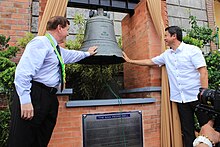
On May 23, 2016, the 400-year old "San Pedro" bell made from alloy of gold, silver, and copper has been returned to the Saints Peter and Paul Parish Church, after American soldiers during the Philippine–American War in 1901 took it from the church to West Point Academy in New York.[39]
Government
Local government
Just as the national government, the Bauang's municipal government is divided into three branches: executive, legislative, and judiciary. The judicial branch is administered solely by the Supreme Court of the Philippines. The LGUs have control of the executive and legislative branches.
The executive branch is composed of the mayor and the barangay captain for the barangays.[40] The legislative branch is composed of the Sangguniang Bayan (town assembly), Sangguniang Barangay (barangay council), and the Sangguniang Kabataan for the youth sector.
The seat of Government is vested upon the Mayor Menchie L. de Guzman who holds office since June 30, 2019, at the Bauang Town Hall. The Sangguniang Bayan is the center of legislation.
Elected officials
| Position | Name |
|---|---|
| Congressman | Sandra Y. Eriguel |
| Mayor | Menchie L. de Guzman |
| Vice-Mayor | Henry A. Bacurnay Jr. |
| Councilors | Tanya Roberta A. de Guzman |
| Angelo S. Aquino | |
| Lorie Ann G. de Guzman | |
| Warlito B. Daus Jr. | |
| Gabriel "Gabby" A. Sotto | |
| George B. Picardal | |
| Donny Caezar D. Baradi | |
| Danilo P. Abuan |
Infrastructure
1590 Energy Corporation The Bauang Diesel Power Plant formerly owned by the Bauang Private Power Corporation (BPPC) is a diesel-fired power plant that commenced operations in July 1995 with a 215 MW-capacity. State-owned National Power Corporation and the First Private Power Corp. (FPPC) entered into a Build-Operate-Transfer Agreement for the BPCC for a period of 15 years.
On July 26, 2010, after the BOT expiration, it was turned over to the NAPOCOR and the Power Sector Assets and Liabilities Management Corp. (PSALM) and later to the Provincial Government of La Union. Both Viviant Energy Corporation and Gigawatt Power, Inc. under the 1590 Energy Corp. operates the Bauang power facility provide the additional supply to the Luzon grid.
Major facilities inside the plant include a substation, two 100,000 bbl steel fuel storage tanks, sludge treatment plant, and five auxiliary buildings consisting of an administration building (812 sq.m), maintenance building (981 sq.m), warehouse building (591 sq.m), guest house (583 sq.m), bunkhouse (660 sq.m), and a canteen (550 sq.m).
The world's largest medium-speed power station in Bauang maintains an IMS certification for ISO 9901:2000, ISO 14001:2004, and OHSAS 18001 from Certification International.
PLDT Asia-Pacific Cable Network (APCN) in Baccuit Sur A Digital Optical Cable System for telecommunications services linking Hong Kong, Indonesia, Japan, Korea, Malaysia, Taiwan, Thailand, Singapore, and the Philippines is strategically located at the coastline barangay of Baccuit Norte in Bauang, La Union.
The facility, owned by the Philippine Long Distance Telecommunications Company, aims to benefit the users of telecommunications services and consequently stimulate the rapid expansion of business and government intercourse between the Philippines and the foreign countries to be served.
Education
Elementary schools:
- Acao Elementary School - Barangay Acao
- Baccuit Elementary School - Barangay Baccuit Sur
- Bagbag Elementary School - Barangay Bagbag
- Ballay Elementary School - Barangay Ballay
- Baratao Elementary School - Sitio Baratao, Barangay Acao
- Bauang North Central School - Barangay Central East
- Bawanta Elementary School - Barangay Bawanta
- Bigbiga Elementary School - Sitio Bigbiga, Barangay Lower San Agustin
- Boy-Utan Elementary School - Barangay Boy-Utan
- Bucayab Elementary School - Barangay Bucayab
- Cabalayangan Elementary School - Barangay Cabalayangan
- Calumbaya Elementary School - Barangay Calumbaya
- Casilagan Integrated School - Barangay Casilagan
- Guerrero Elementary School - Barangay Guerrero
- Palugsi-Limmansangan Elementary School - Barangay Palugsi-Limmansangan
- Parian Este Elementary School - Barangay Parian Este
- Parian Oeste Elementary School - Barangay Parian Oeste
- Paringao Elementary School - Barangay Paringao
- Payocpoc Elementary School - Barangay Payocpoc Sur
- Pudoc Primary School - Barangay Pudoc
- Pugo Elementary School - Barangay Pugo
- Quinavite Elementary School - Barangay Quinavite
- Saint Anthony Montessori Educational Network, Inc. (Private) - Barangay Central East
- Saints Peter and Paul Learning Center (Private) - Barangay Central East, beside the Church
- San Agustin Elementary School- Barangay Upper San Agustin
- Santiago Elementary School - Barangay Santiago
- Santa Monica Elementary School - Barangay Santa Monica
Secondary schools:
- Baccuit National High School - Barangay Baccuit Sur
- Ballay National High School - Barangay Ballay
- Bawanta National High School - Barangay Bawanta
- Casilagan Integrated School - Barangay Casilagan
- Don Eulogio de Guzman Memorial National High School - Barangay Calumbaya
- Eulogio Clarence de Guzman Junior Memorial National Vocational HS (formerly Acao National High School) - Barangay Acao
- Paringao National High School - Barangay Paringao
- Sacred Heart School (Private) - Barangay Central East
- Saint Anthony Montessori Educational Network, Inc. (Private) - Barangay Central East
Tertiary:
- La Union Colleges of Science and Technology (Private) - Barangay Central West
- Saint Louis College Development Center (Private)
Bauang in Literature
Bauang, specifically Barangay Nagrebcan on the shores of the Balili River, features prominently in the works of Philippine literary icons Manuel Arguilla and F.Sionil Jose.[42][43]
Notable personalities
- Manuel Arguilla, one of the Philippines' most influential English writers, grew up in Bauang's Barrio Nagrebcan[44][8]
Gallery
-
Municipal hall
-
Police station and Legislative building
-
The landmark Bauang Farmers‑Fisher's Monument
-
Bauang Commercial Center (public market)
-
Town plaza overlooking Sts. Peter & Paul Parish Church
References
- ^ Garcia, William June (April 8, 2015). "Grape-picking an attraction in Bauang". The Manila Times. Archived from the original on January 6, 2016. Retrieved February 15, 2019.
- ^ "DOLE-1 infuses P1-M worth of livelihood assistance to Bauang, La Union's carabao-based enterprise". Department of Labor and Employment Ilocos Region. July 21, 2015. Archived from the original on February 15, 2019. Retrieved February 15, 2019.
- ^ Municipality of Bauang | (DILG)
- ^ "2015 Census of Population, Report No. 3 – Population, Land Area, and Population Density" (PDF). Philippine Statistics Authority. Quezon City, Philippines. August 2016. ISSN 0117-1453. Archived (PDF) from the original on May 25, 2021. Retrieved July 16, 2021.
- ^ a b c Census of Population (2020). "Region I (Ilocos Region)". Total Population by Province, City, Municipality and Barangay. Philippine Statistics Authority. Retrieved July 8, 2021.
- ^ "PSA Releases the 2021 City and Municipal Level Poverty Estimates". Philippine Statistics Authority. April 2, 2024. Retrieved April 28, 2024.
- ^ "Taboan Writers Festival set in La Union". Philippine Information Agency Website. November 21, 2017. Retrieved July 6, 2020.
- ^ a b José, Francisco Sionil (December 8, 2003), "A Sense of Time and Place", Philippine Graphic
- ^ Sotelo, Yolanda (June 4, 2017). "House in literary classic defies time". The Philippine Daily Inquirer. Retrieved July 6, 2020.
- ^ a b "Bauang History | Municipality of Bauang". Retrieved September 1, 2021.
- ^ "History of Bauang". December 19, 2012. Archived from the original on December 19, 2012. Retrieved September 1, 2021.
- ^ DEACON, KENNETH J. (1960). "Seizure of the Bauang Bridges". The Military Engineer. 52 (348): 292–294. ISSN 0026-3982. JSTOR 44575472.
- ^ "2010 Census of Population and Housing: Population Counts - Cordillera Administrative Region" (PDF). Philippine Statistics Authority, April 4, 2012. Archived from the original (PDF) on June 26, 2015. Retrieved November 16, 2014.
- ^ "Bauang: Average Temperatures and Rainfall". Meteoblue. Retrieved April 26, 2020.
- ^ Census of Population (2015). "Region I (Ilocos Region)". Total Population by Province, City, Municipality and Barangay. Philippine Statistics Authority. Retrieved June 20, 2016.
- ^ Census of Population and Housing (2010). "Region I (Ilocos Region)" (PDF). Total Population by Province, City, Municipality and Barangay. National Statistics Office. Retrieved June 29, 2016.
- ^ Censuses of Population (1903–2007). "Region I (Ilocos Region)". Table 1. Population Enumerated in Various Censuses by Province/Highly Urbanized City: 1903 to 2007. National Statistics Office.
- ^ "Province of La Union". Municipality Population Data. Local Water Utilities Administration Research Division. Retrieved December 17, 2016.
- ^ "Poverty incidence (PI):". Philippine Statistics Authority. Retrieved December 28, 2020.
- ^ "Estimation of Local Poverty in the Philippines" (PDF). Philippine Statistics Authority. November 29, 2005.
- ^ "2003 City and Municipal Level Poverty Estimates" (PDF). Philippine Statistics Authority. March 23, 2009.
- ^ "City and Municipal Level Poverty Estimates; 2006 and 2009" (PDF). Philippine Statistics Authority. August 3, 2012.
- ^ "2012 Municipal and City Level Poverty Estimates" (PDF). Philippine Statistics Authority. May 31, 2016.
- ^ "Municipal and City Level Small Area Poverty Estimates; 2009, 2012 and 2015". Philippine Statistics Authority. July 10, 2019.
- ^ "PSA Releases the 2018 Municipal and City Level Poverty Estimates". Philippine Statistics Authority. December 15, 2021. Retrieved January 22, 2022.
- ^ "PSA Releases the 2021 City and Municipal Level Poverty Estimates". Philippine Statistics Authority. April 2, 2024. Retrieved April 28, 2024.
- ^ "Municipality of Bauang, La Union Philippines". Archived from the original on December 18, 2012. Retrieved December 8, 2012.
- ^ Jose, F. Sionil (July 28, 2014). "A visit to Arguilla Country: Literature as patriotism". Philstar.com. Archived from the original on September 30, 2018. Retrieved April 19, 2022.
- ^ Dalisay, Butch (December 3, 2017). "Handfuls of fragrant hay". Philstar.com. Archived from the original on July 6, 2020. Retrieved April 19, 2022.
- ^ Sotelo, Yolanda (June 4, 2017). "House in literary classic defies time". INQUIRER.net. Archived from the original on June 3, 2017. Retrieved April 19, 2022.
- ^ "Catholic Directory of the Philippines - Claretian Communications Foundation, Inc". Archived from the original on December 31, 2013.
- ^ David M. Cheney. "San Fernando de La Union (Diocese) [Catholic-Hierarchy]".
- ^ Local Government Units: Municipality of Bauang - Province of La Union :: Official Website Archived July 10, 2012, at the Wayback Machine
- ^ Charmaine (October 5, 2017). "[RMM] Instituto Nuestra Senora de la Merced de Barcelona".
- ^ "List of Parishes of the Roman Catholic Diocese of San Fernando de la Union | Philippine Churches". Archived from the original on November 6, 2012. Retrieved December 8, 2012.
- ^ "San Pedro bell returned to PH after 101 years at West Point chapel". balitangamerica.tv. May 2, 2016.
- ^ "US returns La Union's 400-year-old bell". The Philippine Star. May 19, 2016.
- ^ "West Point, NY chapel returns San Pedro bell to Bauang, La Union church". Asian Journal. May 6, 2016. Archived from the original on May 29, 2016. Retrieved May 29, 2016.
- ^ Beleo, Erwin G. (May 23, 2016). "400-year old San Pedro bell returns to its original home". Manila Bulletin. Retrieved October 2, 2016.
- ^ Local Government Code of the Philippines, Book III Archived March 26, 2009, at the Wayback Machine, Department of the Interior and Local Government official website
- ^ "2019 National and Local Elections" (PDF). Commission on Elections. Retrieved March 6, 2022.
{{cite web}}: CS1 maint: url-status (link) - ^ Dalisay, Butch. "Handfuls of fragrant hay". Retrieved July 6, 2020.
- ^ Remoto, Danton. "From Nagrebcan to never-never land". Retrieved July 6, 2020.
- ^ José, Francisco Sionil (2005), Alejandro Padilla (ed.), Termites in the Sala, Heroes in the Attic:Why We Are Poor, Ermita, Manila: Solidaridad Publishing House, ISBN 971-8845-41-0
Sources
- "Brief History and Profile of Bauang". Archived from the original on March 18, 2007. Retrieved May 2, 2006.





